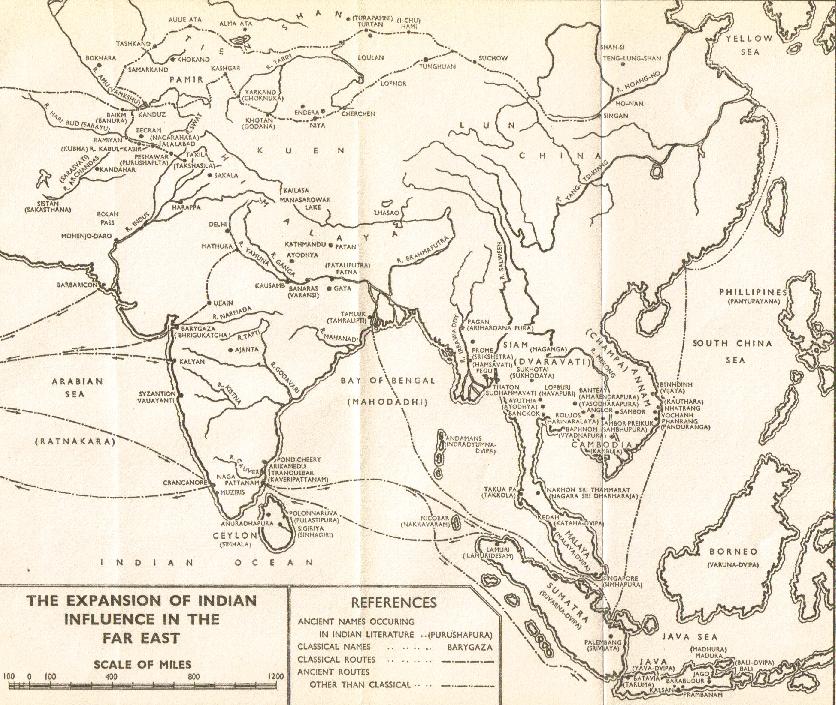A Sanskrit-Chinese dictionary compiled in Central Asia in the seventh and eighth centuries calls the countries situated in the Southern Seas as Jipattala which Sylvain Levi interprets as the Indian archipelago and the neighboring islands. These two Indias were called by the name of Bharatavarsha which included the nine islands ofDvipantara-Bharata, each separated from the other by sea. The names of those islands were Indra-dvipa, Kaseru, Tamravarna, Gabhastiman, Nagadvipa, Saumya, Gandharva and Varuna.
Masudi, born in Baghdad, the Arab geographer, historian and philosopher, states in his work called Muruj adh-Dhahab or'Meadows of Gold' written in 942 A.D. that India in those days "extended over sea and land and bordered on the country called Zabag (Sumatra or Greater Java) ruled by the king of these islands."
Professor Sylvain Levi has shown from references in theRamayana, Mahabharata, Mahaniddesa, and Brihat-Katha that the products of Burma and Malaya Peninsula were known to Indian merchants and sailors, and also some of its ports such as Suvarnakudya, Suvarnabhumi, Takkolam, Tamlin and Javam from at least first century A.D.
Masudi, born in Baghdad, the Arab geographer, historian and philosopher, states in his work called Muruj adh-Dhahab or'Meadows of Gold' written in 942 A.D. that India in those days "extended over sea and land and bordered on the country called Zabag (Sumatra or Greater Java) ruled by the king of these islands."
Professor Sylvain Levi has shown from references in theRamayana, Mahabharata, Mahaniddesa, and Brihat-Katha that the products of Burma and Malaya Peninsula were known to Indian merchants and sailors, and also some of its ports such as Suvarnakudya, Suvarnabhumi, Takkolam, Tamlin and Javam from at least first century A.D.
The Periplus of the Erythrean Sea written by a Greek sailor of Egypt in the first century A.D. mentions many ports of India then existing on its Western and Eastern coasts. Ptolemy in his Geography written in the second century A.D. refers to the ports of Malaya Peninsula, Java, and Sumatra and the Indian port of Palura from which voyages were directly made to Malaya Peninsula. Ptolemy's reference in the second century to Iabadiou certainly represents the Prakrit from of the Sanskrit Yavadvipa.
Indian culture flourished, reaching islands as far as Borneo and Bali. Some of it survives even today, evident from the quaint proto-Sanskritic names that still prevail in Thailand, Malaysia, Cambodia and Indonesia. Borneo's capital, Bandar Seri Begawan is a colloquialisation of Sri Bhagwan, Bali's headquarters, Jeyapora, is nothing but Jaipur, localised, just as Aranya Prathet in Thailand is simply the jungle province or Aranya Pradesh. Fortunately, much of the structure of the gigantic temple city of Angkor Vat has survived the ravages of the Khmer Rouge, while Borobudur in Java still shines in resplendent glory.
Indian culture flourished, reaching islands as far as Borneo and Bali. Some of it survives even today, evident from the quaint proto-Sanskritic names that still prevail in Thailand, Malaysia, Cambodia and Indonesia. Borneo's capital, Bandar Seri Begawan is a colloquialisation of Sri Bhagwan, Bali's headquarters, Jeyapora, is nothing but Jaipur, localised, just as Aranya Prathet in Thailand is simply the jungle province or Aranya Pradesh. Fortunately, much of the structure of the gigantic temple city of Angkor Vat has survived the ravages of the Khmer Rouge, while Borobudur in Java still shines in resplendent glory.
"A Tamil inscription found in Thailand, at the site of Takua Pa, testifies to southeast Asia commerce with the Pallava region. A poem written by the 8th century Vaishnava saint, Tirumangai, speaks of ports where "ships rode at anchor, bent to the point of breaking, laden as they were with wealth, with big-trunked elephants, and with mountains of gems of nine varieties."
(source: Indian Art - By Vidya Dehejia p. 186).
(source: Indian Art - By Vidya Dehejia p. 186).
Names like Indo-China. Further India, Insulindia, Indonesia, etc., which are applied to various parts of South East Asia and the Far East are as significant as 'Ser-Inida.' This region is geographically an extension of India and Ptolemy rightly calls it 'Trans-Gangetic India.'
(source: Cultural Heritage of Ancient India - By Sachindra Kumar Maity p.121). For a virtual tour of extensive art from Southeast Asia, visit


No comments:
Post a Comment